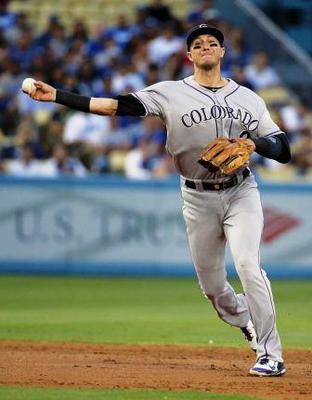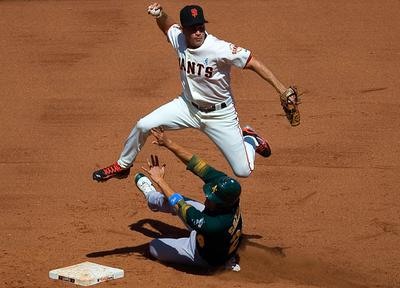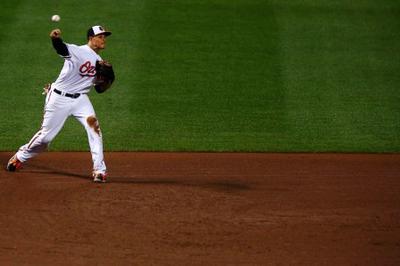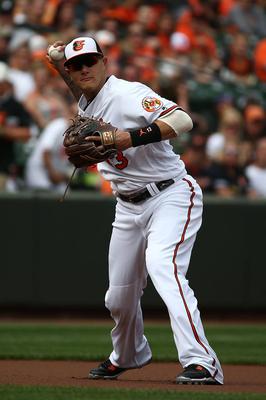Sidearm, breaking the cycle.

Troy Tulawitski

Omar Visquel

Manny Machado Throwing Mechanics

Manny Machado On Line
Annonymous asked: I coach 7,8 and 9 year olds.
My 2 most talented players have developed a sidearm throw. They watch Tulowitzki and want to be like him.
The dads are no help because they see success and don't want to fix something that ain't broken!!!
How do I get through and break the habit?
Rick answered: Thank you for your question.
As young players we all attempt to imitate our favorite a athletes in the sports we participate in.
There are many things that can be imitated and not cause a young player any difficulty, as they work their way through the baseball system.
Players at the professional level are able to do things with a baseball that the majority of us will never be able to create.
Each of these players have been taught, and have perfected, the basic fundamentals of all aspects of the game.
That base provides them the platform to add all the various spectacular plays we see them make, on a daily basis.
Within the game of baseball, throwing mechanics are essential. Outside of the DH, there is not a position on the field where you can be successful if you do not throw well.
Poor throwing mechanics will, over time, cause a player to develop various arm issues, either elbow or shoulder related.
I don't know if you have been on my rookie and advanced throwing pages, under Baseball Instruction in the drop down navigation. If not, that may provide you with setting up a throwing program for all the players on your team, whereby it is a format you use everyday at practice and before games.
Quite often "warming up" is just a social activity for teams. Since it is something they all do, every day, it is an opportunity to improve on throwing and receiving skills.
By the time players get to the high school level, if they haven't mastered the mechanics of these skills, it is very apparent the first day of practice, when you set them up to throw.
By that time, those bad habits are their everyday mechanics. While it is still possible to restructure them and move forward, quite often their response is,"I have always thrown this way".
Not much you can do with the dads theory of, "don't want to fix it, if it ain't broke." It's already broke, they just can't see it.
Go about setting up a structured throwing routine for the whole team, one that they follow every practice, as well as every game.
Explain to them that good throwing mechanics will allow them to throw more accurately, less stress on their arms, and increase their velocity and distance.
It doesn't mean they won't need to develop other throwing platforms such as sidearm, submarine an other additional throwing platforms that will come into play at some point; but everything throwing and receiving develops off of the basic fundamentals.
The players images above are just a few of the many launching positions players end up in.
When they see that you believe the throwing mechanics are important, they will think so also.
Stretching your muscles is "warming up". Think about playing catch before practice and games, not as warming up; but working on throwing and receiving mechanics.
When they have their arm slot correct, the released baseball will be spinning front to back. If they are throwing sidearm, the ball will rotate sideways, and over a longer distance will slice away from their intended target. They can see that, and start to make some adjustments.
It all takes time and patience; but will pay big dividends for them over their time in baseball.
They will see a difference in accuracy, once they start looking to keep the throw under the button of their partners cap, outside the edge of each shoulder, and above their belly button.
Specify the number of throws you want each of them to make at a given distance, then they back up to the next distance and repeat....an so on until they are basically throwing long toss( at whatever distance you feel they can handle.)
Then, end it with a set number of throws, or a time limit, from where they ended long toss, and work their way back down to where they began.
Each day they should be getting more accurate, their ball rotation should be getting more consistent, their footwork should be more animated and you should see them moving to and around the baseball, setting their feet and making a return throw, all the time keeping their glove and their throwing hand in close proximity to each other, working on their take-up time, as they reset their feet.
Lot of stuff going on, all beneficial.
Play Catch, Not Fetch!
Good luck as you go forward.
Yours in baseball,
Rick





